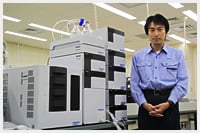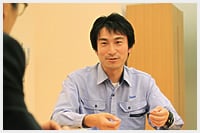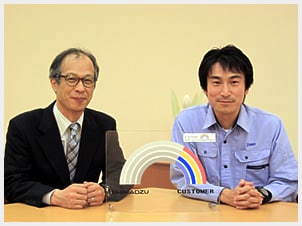
Life Science

INDUSTRY
Life Science, Small Molecule Pharmaceutical
KEYWORD
INTRODUCTION SERVICE&PRODUCTS
The Center for Ophthalmic Research and Development at Santen Pharmaceutical Co., Ltd. uses Shimadzu Prominence UFLC, UFLCXR, and Nexera for analytical LC and LC/MS in the field of pharmacokinetics. With its exceptional basic performance and "All-round LC" concept, Nexera accommodates a diverse range of applications to meet customers' demands. Since its release, Nexera has garnered an excellent reputation. A customer's requirements with respect to Nexera and his valuable opinions on the latest addition to the Nexera family, Nexera MP, are presented below.

Tatsuo Yoshimura
Non-clinical Research Group
Ophthalmic Research & Development Center
*Affiliates and titles of the interviewee are current as of the time of reporting.
Santen Pharmaceutical Co., Ltd.
URL
http://www.santen.com/index.jsp
Please describe the work you do with Shimadzu high-performance liquid chromatographs.

I mainly use it for the quantitative analysis of biosamples from the initial stages of drug discovery up to the development stage. Other uses include qualitative analysis, such as the structural analysis of metabolites, and measurement of the physicochemical properties of compounds, such as solubility and Log D, involved in pharmacokinetics.
You use a UV detector for Log D and other physicochemical properties measurements and high-performance liquid chromatographs as front-end LCs for LC/MS for qualification and quantitation, don't you?
Yes, that's right. At my company, we use Prominence UFLC and UFLCXR as front-end LCs for MS. We use Nexera as a standalone LC. We mainly use a UV detector for physicochemical property measurements but sometimes we use MS. A rack changer is attached to all the systems.
Please explain the points and criteria you used to select the MS front-end LC to analyze biosamples for pharmacokinetics.

Because MS is so highly sensitive, low carryover was the major point. It was also important for the instrument performance, including injection speed and pressure resistance, to support the faster speeds that analytical technologies have achieved in recent years. Due to the greater number of samples handled at the faster analysis speeds, a method for the automated analysis of large numbers of samples, such as using a rack changer, is also required.
I guess that the carryover standard changes according to the dynamic range. What is your approximate target value?

Basically, we often perform quantitative analysis with a dynamic range of 3 orders of magnitude. However, due to enhanced MS performance, 4 orders of magnitude may be used, if necessary. In terms of the dynamic range, observation is required for samples with concentrations several times lower than the lower limit of quantitation.
You mean that in order to perform quantitative analysis with a dynamic range of 3 orders of magnitude, for example, the carryover must not exceed one-tenth of the lower limit of quantitation, don't you? In that case 1 in 104, or 0.01 %, seems to be about the maximum limit of tolerance. Of course, zero carryover is the ideal. But as zero is impossible, around 0.01 to 0.0001 % seems to be an acceptable range, doesn't it?
Yes, that's right. I think rinsing capacity is necessary; this allows the carryover to be kept under one-fifth the lower limit of quantitation (LLOQ), or under a further fraction if possible.
The reason that Shimadzu focuses on carryover is that, in the world of MS, and in pharmacokinetics research in particular, LLOQ is determined by carryover rather than MS detector sensitivity. While you may want to analyze samples with lower concentrations, in practice LLOQ increases due to carryover in some cases, doesn't it?
Yes. I think the tubing and fittings and column performance also affect it.
At the moment, you mainly use UFLC and XR as the MS front-end LCs. Are any special techniques used to rinse the needle?

We don't have many problems with the UFLC or XR at the moment. With two-solution rinsing, the carryover causes no problems during analysis. We are quite satisfied with the performance in respect to carryover.
Do you use any particular rules or techniques for rinsing with two solutions?
The weak rinse solvent is basically similar to the mobile phase. The other rinse solvent is mostly one that best dissolves the compound.
I guess pharmacokinetics often requires batch operations. What is the typical number of samples and microplates per analysis?
The samples often fit in 1 to 3 microplates. The number of samples increases for the measurement of physicochemical properties, and a rack changer is required to handle the microplates.
How many microplates are used to analyze samples in Log D measurements?
With the high throughput at the sample preparation stage at our company, the analysis is usually performed with about 6 to 10 microplates at a time.
The rack changer can hold 12 microplates, and that is still enough, I suppose. Do you have any other requirements or suggestions regarding the performance or specifications?

We are basically satisfied at the moment. But some methods, like using disposable needles to allow replacement, would help meet our target of zero carryover. Also, metal tubings are used to maintain the pressure resistance of an ultra-fast LC. This concerns me as it relates to the adsorption of highly basic or highly fat-soluble compounds. Developments in hardware and column technology that overcome this problem would be very welcome.
We are currently developing and evaluating a various types of tubings and fittings and other hardware, and look forward to introducing them to you. What column particle sizes do you currently use for ultra-fast LC?
Rather than microparticle size, we mainly use a particle size of approximately 3.5 μm. We often use a 1.8 μm particle size for standalone ultra-fast LC. But there are few opportunities to use columns with fine particle sizes for LC/MS, as the ionization efficiency places restrictions on the flow rate. The main functional group we use is C18, but will occasionally use another functional group as a second choice. We also use the core-shell type column*, which is popular at the moment. It offers the great benefits of obtaining sharp peaks while permitting mobile phase flow at low pressure.
* "Core-Shell" is a registered trade mark of Phenomenex, Inc.
I think that the column length is about 5 cm. Do you ever use 1 cm- or 2 cm-length columns?
We sometimes use them for high-throughput analysis, where precise separation is not needed. That is, for analysis where speed and the number of samples are the major considerations.
With many samples and a short analysis time, you must also be concerned about the injection speed of the autosampler.
Yes, that's very important. We saw demonstrations of a number of instruments before we introduced Nexera, and the time for sample injection was one of our evaluation criteria.
Were there quite large differences, in practice?

The Nexera injection speed was significantly faster than other manufacturers' products. We selected Nexera by looking at its overall performance, not only the autosampler performance, such as the injection speed and rack changer temperature control. The high sensitivity of the fluorescence detector was also quite appealing.
I'm happy to say the Shimadzu RF-20Axs fluorescence detector has gained a high reputation among customers for its superior sensitivity. What kinds of applications do you use it for? When comparing MS and fluorometric detection for newquinolone antibacterial agents, for example, do you find cases where the fluorescence detector achieves higher sensitivity than triple quadrupole MS?
Yes, we do. Our company manufactures newquinolone eye drops. This results in many related analysis tasks and the sensitivity of the fluorescence detector is very important. In addition to its high sensitivity, the RF-20Axs supports high-speed analysis and offers excellent daily analysis reproducibility.
I see. I'd like to take this opportunity to ask you whether you would find the SIL-30ACMP autosampler for the new Nexera MP useful. The new SIL-30ACMP offers a faster injection speed than the Nexera Series SIL-30AC and can accommodate six microplates, without the addition of a rack changer.

The shorter injection time would significantly reduce the total analysis time for multi-sample analysis, making it an appealing product. What is its footprint?
Each Shimadzu LC unit is 260 mm wide. The Nexera MP system has the width of two of these units placed side-by-side.
That means it is a lot smaller than a system with a rack changer, correct?
Yes, that's right. The small CTO-30AS column oven for MS can be attached as an option to the SIL-30ACMP autosampler. This configuration also fits within two module widths. The column oven can accommodate columns up to 5 cm for use at temperatures between 5 °C and 80 °C above room temperature.
We have always found a chopstick-case-like column oven to be adequate and thought it should be installed directly in front of the ion source. From the viewpoint of specialization for high-speed analysis, a column size up to 5 cm should be adequate.
The CTO-30AS permits height and angle adjustment, which allows the column outlet to be moved close to the interface.

A compact instrument with a small footprint is very appealing. Since space is restricted in laboratories, I think in the future there will be demands for greater compactness in MS and LC instruments as well as for higher instrument performance.
Are there any measures you would like us to take for the analysis of biosamples? Shimadzu basically employs modular units, focusing on automatic pretreatment using valves. I was wondering if there was some way we could put these to use.
Programming functions would be useful. Complex pretreatment processes are often required to analyze biosamples, and these can be difficult to automate. However, comprehensive functions, including simple dilution in the autosampler or the addition of something from the control rack, could be employed in many analysis scenarios.
Nexera offers pretreatment functions that permit auto-dilution and automatic addition of internal standards.
For a comparatively simple test system, such as for Log D measurements, pretreatment could be automated by simply programming the dilution and split injection. I think that providing the autosampler with dilution, intake, and split injection functions would extend its range of applications.
Aqueous-layer and octanol-layer analyses are required for Log D measurements, aren't they? A Nexera application for Log D measurement was announced at HPLC 2011. It allows analysis by directly adding the octanol layer and aqueous layer to the sample vials and using pretreatment functions to first inject the aqueous layer and then inject the octanol layer after slightly raising the needle position.
We use a liquid handler to extract from the top layer or lower layer. If this were possible using the LC autosampler, it would significantly improve our work efficiency. But as the upper octanol layer readily increases in concentration, I have concerns about carryover. I wonder if the Shimadzu instrument can also reduce carryover.
When the needle penetrates the octanol layer, its solvent can enter the needle. However, the instrument can be programmed to use air to prevent ingress of the octanol layer. We tested whether analytical results matched for automatic pretreatment and manual operation, and obtained comparatively precise and satisfactory results. When it is ready, we will send you the conference poster with an example of how to use Nexera.
Finally, I'd like to ask you your impression of Shimadzu as a company. Each company has its own flavor. What is the brand image you associate with Shimadzu Corporation?

The word that springs to mind is "honest." But that may just be my impression of day-to-day contact with Shimadzu sales staff. I get the impression of an honest company that deals with me extremely conscientiously. On the other hand, the company can seem a little rigid.
Thank you for your time today.


The Nexera UHPLC was developed according to the three pillars of "Maximizing Throughput," "Maximizing Performance," and "Maximizing Expandability." Low carryover is a feature of Shimadzu LCs. Our major aim was to further reduce the already low carryover when using it as an LC/MS front end. The ultra-low carryover and new rinsing functions offered by Nexera achieve the full potential of ultra-high-sensitivity LC/MS/MS and provide an analysis environment that offers the wide dynamic range demanded for pharmacokinetics testing.